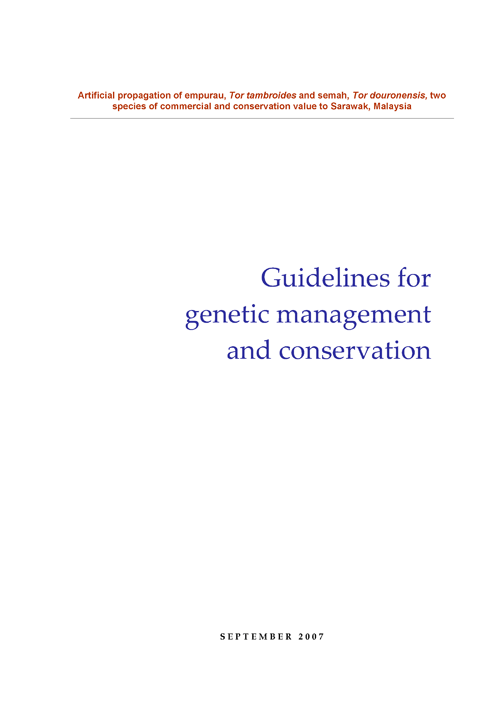Guidelines for genetic management and conservation of empurau, Tor tambroides and semah, Tor douronensis
12 November 2007 | 2211 Downloads | .pdf | 779.35 KB | Better management practices, Freshwater finfish, Genetics and Biodiversity, Malaysia
This document presents i) current status on genetic diversity of empurau and semah in Sarawak, Malaysia, including taxonomic status, and ii) a management guideline based on genetic data.
The mahseer species, Tor tambroides and T. douronensis, are often referred to as empurau and semah, respectively in Sarawak, Malaysia. The two species are indigenous to the State with an aquaculture potential and of conservational value. Empurau and semah are well sought after due to high market value as well as being attractive sport fish. Semah is considered the State Fish of Sarawak, and juveniles of both species are also increasingly sought after by the aquarium industry (Ng, 2004). Semah are found in most major river systems of Sarawak, while empurau are restricted to some rivers, and both species often inhabit upper reaches of the headwaters. They also occur in Peninsular Malaysia and are distributed throughout southeast Asia from Indonesia to southern China (Kottelat et al., 1993, Roberts, 1999, Zhou and Cui, 1996).
Many anthropogenic activities, including the recent developments in watersheds within the natural distribution of empurau and semah, as well as increased fishing pressure have led to depletion of their natural stocks. As such there is an urgent need to replenish such depleted stock as well as reducing pressure that affects the well being of natural populations of empurau and semah.
The Government of Sarawak, recognising the importance of these two species, made an attempt to evaluate their aquaculture potential, including captive breeding using long-term pond-reared broodstock, commencing in the 1990s. However, limited success was achieved until the period 2002-2004 through an international collaboration, where researchers from Australia and Sarawak were able to breed both species using hormone induction techniques, popularly referred to as hypophysation, on long-term, pond-reared broodstock. Success in artificial propagation of empurau and semah would bring about significant developments in term of aquaculture and conservation. On the one hand, fish produced from aquaculture can be used to replenish the wild stocks - the practice often known as stock enhancement, and on the other hand, fishing for food fish will also be reduced due to the availability of cultured fish.
However, it is important to note that aquaculture and stock enhancement could be counter-productive if genetic aspects of broodstock management are not taken into account or broodstock are not properly managed. Detrimental genetic impacts of poorly or inappropriately managed fish breeding programs for both aquaculture and stock enhancement have well documented over the last two decades (Waples, 1991). When fish are removed from the natural environment and placed in a cultured environment and domesticated, random genetic drift and domestication effects (new and greatly different selective forces act upon fish in the domestic environment compared to the natural environment) alter the gene frequencies and reduce genetic variation. Domestication reduces genetic variability in fish through both selective processes and random genetic drift. Such fish once released in to the natural waters could have potential impacts on altering or diluting natural gene pools, and such events have been documented for many species.
Hybridisation between closely related species can have a detrimental affect on natural gene pools. Interspecific hybridisation among other mahseer elsewhere has been reported. Because of the high level of morphological similarity between empurau and semah there is risk that inadvertent mixing of the two species, especially during breeding, may lead to hybridisation. Therefore hybridisation is an important threat to the genetic integrity of both species.
In order to avoid the above mentioned potential problems, it is crucial that a genetic management plan be developed with the aim to warrant the long-term maintenance of genetic diversity of cultured stocks, as well as to minimise potential adverse effects on the genetic integrity of the wild populations through proper stock enhancement practices. Surveys on current status of genetic variability of empurau and semah are reported herein, and the results from which are used as baseline data for development of a genetic management plan.
Further, this document represents the first example in Asia of a comprehensive genetic management plan that was developed at the inception of industry development and commercialisation, and that takes into account both commercial aquaculture of fish species as well as the conservation and management of wild populations. As such it is imperative that the State Government of Sarawak publicises this exemplary event and brings it to the notice of the rest of Malaysia.
Creative Commons Attribution.

